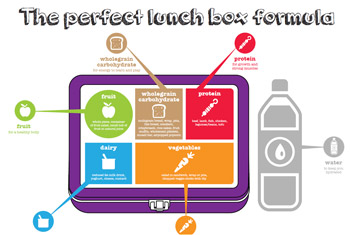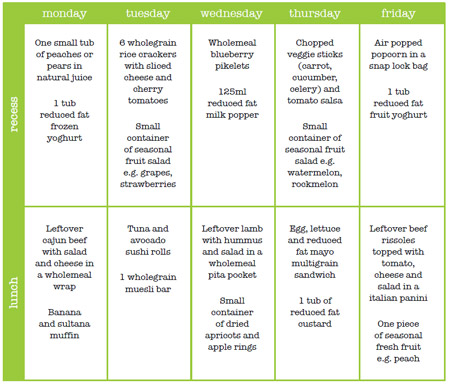Kate Di Prima Back To School Lunch Box Interview

Kate Di Prima Back To School Lunch Box Interview
As students prepare to return for a new school year, new research* commissioned by Meat & Livestock Australia suggests that only one third (33%) of 8-14 year olds pack their lunch box every day. The study of over 400 children showed those who pack their lunch only occasionally are less likely to eat everything in their lunch box than those packing lunch every day - and may be subsequently missing out on critical nutrients and energy to support learning and play.
Experts agree that getting children involved in packing wholesome, nutrient-rich lunch boxes is one of the most important things a parent can provide for their child. Accredited Practising Dietitian Kate Di Prima comments:
'Packing a nutritious school lunch which includes red meat, wholegrain bread, vegetables, fruit and dairy foods provide critical nutrients, such as protein, carbohydrate, iron, zinc and B vitamins; important for energy and learning at school. Including 3 to 4 serves of beef or lamb a week – such as that to fill a sandwich or wrap - provides iron to support brain function and zinc for a healthy immune system. This is especially important as low iron can contribute to tiredness and poor concentration in the classroom."
'Encouraging kids to pack their own lunches filled with foods that they actually enjoy can also prevent lunch skipping, swapping and unhealthy canteen purchasing. Giving kids the opportunity to choose their own lunch box contents promotes a sense of ownership, which can aid in preventing unfinished lunches," Kate added.
Kids are capable of packing their lunches from around the age of 8 or 9. To make it easier for them to do so, Meat & Livestock Australia, together with Kate Di Prima, has devised a handy recess and lunch meal plan, lunch box portion template, balanced meal formula, top lunch box tips for parents and kids and dinner and lunch recipes– all ideal for fast tracking your child to the top of the lunch class!
Kate Di Prima's tips for parents to make child lunch box packing easy:
Timing is key! Encourage kids to prepare as much as they can the night before to avoid the crazy rush in the morning
Provide a sturdy lunch box which has space for 4-5 containers or compartments. Use this as an opportunity to teach your child to -reduce, reuse, and recycle' for our environment
Pre-cut fruit, veggies and cheese and wrap in plastic wrap or store in containers in the fridge. This will prevent the need for kids to use sharp knives in the kitchen
Plan dinner meals which can be used for lunch box leftovers the next day e.g. A barbecue beef meal on Sunday night provides great Monday lunch leftovers for easy sandwich / wrap fillings that kids will love
Colour code food items to correspond with recess and lunch breaks. Eating the right combinations of foods can help with energy, concentration and stamina. Use red stickers for recess and green for lunch
The guide can be downloaded at www.beefandlamb.com.au/lunchbox
 Interview with Kate Di Prima
Interview with Kate Di Prima
Kate Di Prima is an Accredited Practising Dietitian in Brisbane with more than 20 years' experience. She runs two private practice clinics and provides corporate consulting services to many companies. The author of two cookbooks, lunch box cards and co-author of two self-help books, she is passionate about the health and nutrition of families. Kate is regularly asked to present both nationally and internationally on topics relating to children's and family nutrition. Kate has two children: Jack aged 13 and Rosie aged 10.
Question: How important is food and therefore the lunchbox to a children's school day?
Kate Di Prima: This year we conducted a survey to see how many kids were actually involved in preparing their lunchboxes. I have two children myself (10 and 13 years of age) which is a good age group to start getting them involved in filling lunchboxes. However the survey found that only 33% of children in the 8-14 year old age group have anything to do with filling their lunchbox.
Question: Why is it important that children are involved in packing their lunch boxes?
Kate Di Prima: When a child fills their own lunchbox they are more aware of good foods and they know what they are getting when they open their lunchbox which means they are more inclined to eat it. A lot of mothers I speak to, in my practice, say that many children are bringing home an uneaten lunchbox and that's the premise behind this campaign – to get parents having their children who are in the 8-14 year old age group involved in filling the lunchbox.
Question: Are there any pre-packaged foods, purchased at the supermarket, that are safe and nutritious for a lunch box?
Kate Di Prima: Obviously if you start from scratch in any sense of the word, you know what ingredients are going into the lunchbox and these days there are a lot of restrictions in schools regarding food due to allergies. A lot of pre-packaged foods often state 'may contain traces of nuts" which alerts teachers to inform parents that these options are not allowed in school grounds. It's important for people to have a look at labels and also prepare food, themselves.
There are chopped up packets of fruit and SPC Fruit containers are close to fruit options but there are also a lot of options that are as far away from fruit, as I can see!
Question: Can you talk us through the necessaries of a school lunch box?
Kate Di Prima: I like to say that a lunchbox should have four items;
A piece of fresh fruit such as a banana, orange, apple or nectarine which can be placed, easily, in the lunchbox; if kids prefer something smaller try grapes, blueberries or strawberries in a snap-lock bag or container.
A calcium rich dairy food such as a yoghurt or cheese with wholegrain crackers or a fresh milk. If you freeze your milk you can use that as an ice-brick too. Calcium and protein rich products also help kid's bones and their teeth.
A main meal which is the main food that features in the lunchbox that gives them their protein and iron and zinc as these minerals are very important for the immune system, moving oxygen around the body and hormone building especially in young boys. Red meat such as beef, lamb or even egg, legumes, fish or chicken are great.
A vegetable item such as green beans with a dip or carrot and celery sticks with cream cheese. A carrot or zucchini muffin is also a great source of vegetables, my kids love healthy home bake.
Question: At what age should a parent leave their child to pack their own lunch box?
Kate Di Prima: Many 8 year's olds can fill their lunchbox themselves. It's easy to get the ball rolling by making a small area in the fridge and pantry that is their designated lunchbox area. Parents can prepare the area the night before by placing an apple next to the yoghurt with last night's leftovers so it's easy for the child to pack their own lunchbox.
As they get older they should be able to choose from the fridge what they fill in their lunchbox. If you don't start early though, by the time they reach the teenaged years they haven't been taught properly which means they are more inclined to grab the biscuits and chocolate or other packaged foods.
Question: How can we use dinner left overs to create a lunch box for the next day?
Kate Di Prima: The main lunchbox meal can be created with leftovers. Last night's leftovers can be used in a wrap or a roll or even on a salad. And, if they have eaten it the night before, they tend to recognise the food and remember the taste which makes them want to eat it for lunch.
Roll out some bread; add tuna and avocado to make Tuna Sandwiches. If I've made burritos the night before I wrap the meat in a burrito with avocado, lettuce and tomato then wrap an elastic band around the wrap so they can have a little burrito the next day, packaged next to an ice-brick, my kids love it!
Kids like cold things; the food doesn't always have to be warmed. Healthy pizzas can be put into a container and taken off to school for the main meal.
Question: How can parents plan ahead to make lunch packing in busy households successful?
Kate Di Prima: I have put together a grid on www.beefandlamb.com.au/lunchbox where parents can print off the planner and place it on the fridge or in the pantry which gives them a guide to filling the lunchbox. Sitting down on a Sunday afternoon to plan the dinners and lunches is successful which enables parents to make their own grid as well. The grid works as a spreadsheet for the whole household that helps
 planning for the groceries as well.
planning for the groceries as well. Having a designated lunchbox section in the fridge and pantry is also very good idea so everyone is aware of the foods available. Preparation guarantees parents don't fall into the trap of buying processed foods.
Parents should also get online and look out in their major supermarkets for recipe cards which have great recipe ideas that are easy enough for kids to help with.
Tips for Parents to Make Lunch Box Packing Easy
Plan to cook extra at dinner so there are dinner leftovers for sandwich and wrap fillings
Pre-cut fruit and salad vegetables (score mango, slice peach, peel slice carrot, chop cucumber) and wrap in plastic wrap or store in containers in the fridge
Pre-slice cheese to reduce the need for kids to use sharp knives
Bake at home on the weekends and store items in an airtight container or wrap individually in plastic wrap and freeze. Baking at home is also a great way to secretly include more fruit and veggies in the lunch box
Buy yoghurt and custard tubs in 100-125ml ready to grab portion packs
To reduce the need for plastic wrap, purchase small containers that can fit in the lunch box and be washed out at the end of the day
Kids Packing Their Own Lunches – 10 Steps for Success in Busy Households
1. Timing is key! Encourage kids to prepare as much as they can the night before to avoid the crazy rush in the morning
2. Provide a sturdy lunch box which has space for 4-5 containers or compartments. Use this as an opportunity to teach your child to -reduce, reuse, and recycle' for our environment
3. Provide easy to open and close containers with spoons and / or forks that can be used to store foods within the lunch box
4. Teach your child food safety by encouraging them to use a chilled insulator pack to keep foods cool over the summer months
5. Colour code food items to correspond with recess and lunch breaks. Eating the right combinations of foods can help with energy, concentration and stamina. Use red stickers for recess and green for lunch
6. Plan dinner meals which can be used for lunch box leftovers the next day e.g. A barbecue beef meal on Sunday night provides great Monday lunch leftovers for easy sandwich / wrap fillings that kids will love
7. Set aside a small area in both the fridge and pantry that is suitable to your child's height, where they can store items ready for the lunch box
8. Chop a variety of fruits, sprinkle with lemon juice and store in a container in the fridge to make fruit salad easy to grab and go. The fruit salad will keep for a 2-3 days without going brown
9. Rotate the healthy home-bake job through the family to help teach kids how to cook whilst allowing everyone to have a favourite in the lunch box
10. Stick the perfect lunch box template to the fridge to help your child plan and prepare the perfect lunch box
Interview by Brooke Hunter
MORE



